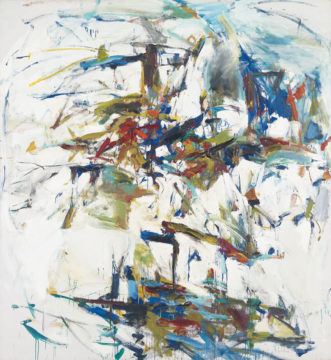Elise Archias at Artforum:
 JOAN MITCHELL’S PAINTINGS from the late 1950s have space in them. They are big surfaces covered with marks, like most Abstract Expressionist paintings made in New York in the same decade, and so they look much flatter than a carefully measured perspectival scene from the 1940s by, for example, Edward Hopper. But compared with almost everything her most productive and now famous peers were doing at the same time, Mitchell’s paintings are practically voluminous.
JOAN MITCHELL’S PAINTINGS from the late 1950s have space in them. They are big surfaces covered with marks, like most Abstract Expressionist paintings made in New York in the same decade, and so they look much flatter than a carefully measured perspectival scene from the 1940s by, for example, Edward Hopper. But compared with almost everything her most productive and now famous peers were doing at the same time, Mitchell’s paintings are practically voluminous.
Consider her George Went Swimming at Barnes Hole, but It Got Too Cold, 1957, for example, alongside Helen Frankenthaler’s Round Trip, 1957. Both pictures invite us to reflect on their dialogue with the landscape-painting tradition, Frankenthaler’s via green triangular “mountains” and a blue “lake” in the foreground, Mitchell’s with the suggestion of a horizon line in the upper right corner and the titular swimming hole. Round Trip showcases a variety of painterly techniques. It is as if Frankenthaler chose each one for its capacity to oppose one of the others: dripping counters drawing; staining denies outlining; Lascaux-like ochre smudges must make room for academic cliché.
more here.
